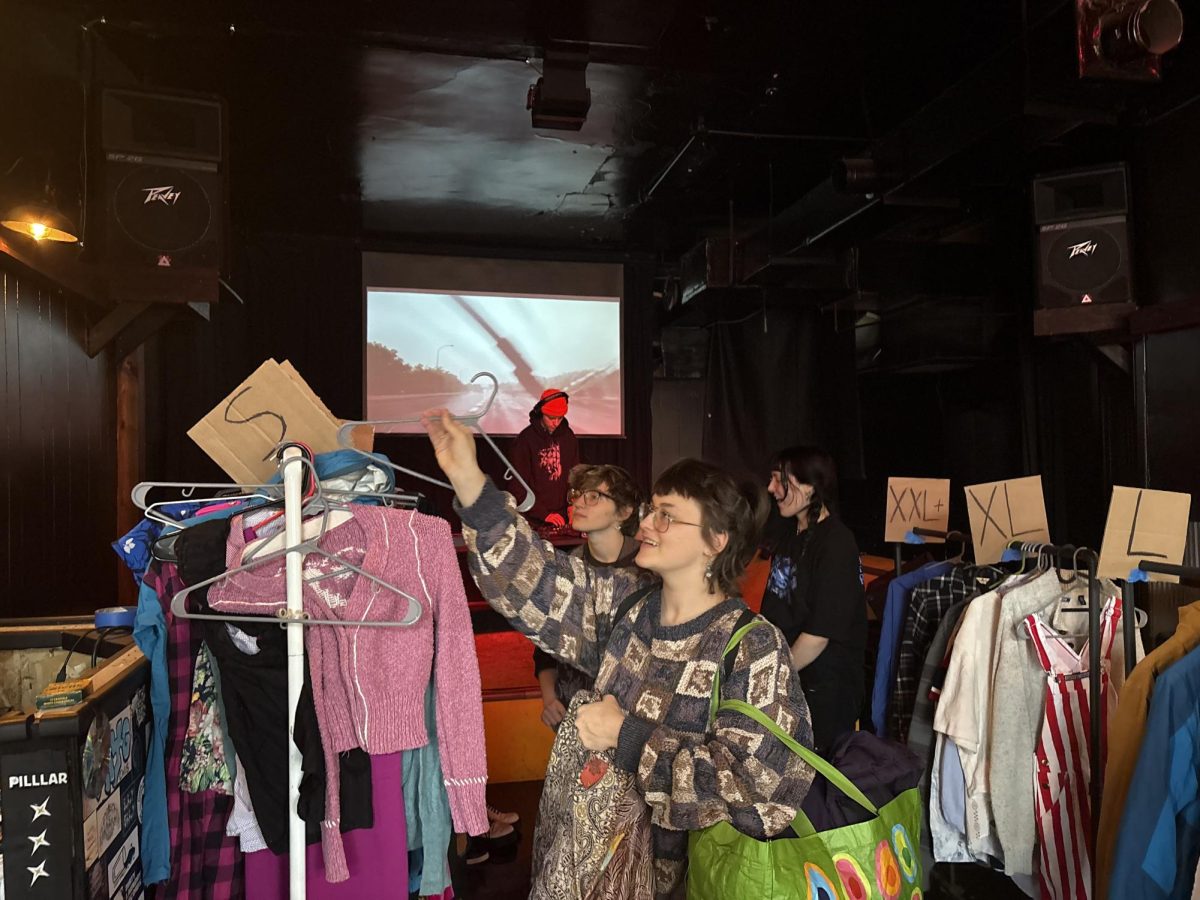The world of comic books is a strange one. As an industry, and maybe more importantly, as an art form, comic books have endured much change in the past 20 years. The comic world has gone through revolving boom and bust periods, blown open its nonsuperhero market and attempted to engage in a more cerebral form of writing, both in the mainstream and in the small press.
Who’d have thought that a fly-over area such as the Twin Cities could be a fairly accurate microcosm of the diversity inherent in today’s larger comic book world? Take a glance at the Twin Cities and you’ll see self-published indie artists, mainstream giants and everything in between, all pumping out material through the medium of comic books.
In the past, these writers and artists might have felt the same pressure that other entertainment media often press onto their talent – namely, that success is only found in New York and Los Angeles. However, that pressure is no longer relevant. With the advent of FedEx, fax machines and the Internet, comic book creators can collaborate from across the globe. And it’s just as easy to sit in your room and draw in Minnesota as anywhere else.
Many comic artists grapple with the fact that the medium into which they pump their dreams and talent isn’t the same as it was when they were growing up.
“Comics still suffer from an identity crisis,” said Vincent Stall, a Minneapolis artist who makes and distributes his own comics. “In the average person’s mind they believe comics have a singular facet which is the superhero comic.”
That notion couldn’t be further from the truth.
“You’re starting to see a whole generation of people who have grown up not reading superhero comics and you’re starting to see that influence on the next generation of creators,” he said.
Stall points to the stability of indie publishers such as Fantagraphics and Drawn & Quarterly, which are havens for personal, story-driven titles that have nothing to do with superheroes.
Stall himself represents the small press creator who is making exactly what he wants and is firmly rooted in his own town.
His catalog of minicomics, which he proudly self-produces under the banner of King Mini International, contains stories of people falling through the cracks of everyday life, a subject he finds intriguing. He sells his books at independent comic shops such as Big Brain Comics in downtown Minneapolis and through his Web site. Print runs for his comics range from about 200 to 500. Stall has no interest in selling his catalog of King Mini books, even to a small press publisher, to attain better distribution. That’s a step he believes he can handle himself. And indeed, his King Mini comics began turning a profit about two years ago. He still works a day job, which used to be primarily in advertising, but with the economy slumping he is currently teaching comic art at the Minneapolis School of Art and Design.
For Stall, the miniature success of King Mini has led to a gig with small press publisher Top Shelf Comix. In the fall, the company will publish Stall’s most ambitious work yet, a 64-page graphic novel called “Brash Tacks.” It’s the story of a moving company that takes care of people’s personal baggage.
While Stall’s stories are peculiar and personal, he acknowledges the stereotype that indie books often endure or maybe even bring upon themselves – many titles feel like autobiographical therapy sessions. And for that he welcomes any influx of divergent ideas into the small press’s softy exterior. “How come nobody’s doing pirate books or more science fiction?” he asked.
Sam Hiti, who works as a house painter, embodies the jolt of difference Stall would like to see in indie comics. Hiti’s art is wildly imaginative and drawn with such power that it’s hard to believe Marvel or DC Comics haven’t tried to scoop him up. But like Stall, he’s refrained from jumping to the majors.
Since deciding to pursue comics seriously four years ago, Hiti has been honing his skills, releasing only one large book along with several minis. He’s very analytical when it comes to his career in comics and thus very patient. He generally works 40- to 50-hour weeks painting houses so he can take two- to three-week breaks to compose his comics. Given that he has only published a few comics, he has raised his visibility considerably by attending the country’s major comic conventions on a yearly basis and by designing a stunning Web site that documents his progress.
In 2002 he won a $5,000 grant to help publish his next project. The grant came from the Xeric Foundation, which is headed by Peter Laird, co-creator of the Teenage Mutant Ninja Turtles. Hiti will use the money to self-publish 3,000 copies of a 120-page graphic novel called “End Times – Tiempos Finales,” which represents the total of everything he’s taught himself. It will be the first book in a series that follows a Hispanic man who hunts really big monsters.
“I’m not really stressing out about making it in the comic book market,” Hiti said. “Things are going to happen and I’ve tried to get as much knowledge as I can and show that off in this book.”
Peter Gross is a good example of someone, like Hiti, who chose to start independent, but then made his way into the majors. Gross jumped into comics during the black-and-white comic boom of the mid-1980s, which was sparked by the Teenage Mutant Ninja Turtle comics. A few years later the boom imploded after the market became over-saturated. Gross found himself at DC Comics, where he has become a fixture in the company’s Vertigo line of story-driven, creator-friendly comics.
And while Gross has been working steadily in the mainstream for more than a decade, he’s generally stayed away from superheroes. Currently he draws the critically acclaimed “Lucifer” for Vertigo and will supply the art for superstar writer Mark Millar’s latest foray into non-superhero comics, “Chosen,” which is about a 12-year-old who finds out he’s the second coming of Jesus Christ. Lately, though, a superhero story has been gestating in his mind. He and another writer are planning to collaborate on a 1930s story that would juxtapose the rise of the superhero with the rise of United States as a world superpower. Gross believes well-written superhero stories always focus on the part of American culture most analogous to themselves.
But as far as Minnesota comic book creators go, a man whose name has become synonymous with superheroes in the industry is Dan Jurgens. Jurgens, who lives in Edina, was the primary architect behind DC’s “Death of Superman” extravaganza that garnered national media attention in 1993. He wrote and penciled the famed issue where the Man of Steel died saving Metropolis. DC Comics sold more than 4 million copies of the issue, Jurgens said, which is more than most pop albums sell nowadays.
“Those were the days,” Jurgens said with a laugh. “Those were the days when sales were mentioned in seven figures.”
Indeed, with a wave of hot new talent and the major companies making bold character changes, the comic industry saw its biggest boom in the early 1990s. This era became known as the speculator boom because comic collectors were buying notable issues in bulk, hoping to cash in later. The trend backfired and that boom also went bust, leaving the industry in a recovery period that is just beginning to even out.
Jurgens has been around for all the ups and downs of the last 20 years, and because of his affiliation with the industry’s biggest hero, he’s often been near the head of the whirlwind. Since breaking into DC Comics in the early 1980s, he’s never struggled to find work and has rarely strayed from superhero-oriented books.
“There is still something about drawing the iconoclastic heroes that is a lot of fun,” he said. “Some of that is the kid in you because you grew up reading Superman and Batman. Another part of it is that sense of grandeur that these stories have. I find it inherently more interesting to draw an entire city falling in on itself or a universe exploding than the more everyday life kind of stuff.”
One local artist who’s found recent success while bouncing between the mainstream and small press is Ryan Kelly of St. Paul. He currently shares artistic chores with Gross on “Lucifer” and he just released a small-press graphic novel called “Giant Robot Warriors.” The latter is a political satire about the United States taking aim at a Middle Eastern country that has just come into giant robot technology.
Kelly, whose friends tell him he always looks stressed out, has been supporting himself for about five years with comic book work, teaching at the Minneapolis School of Art and Design and painting.
“I’m kind of following a million different paths,” he said. “If stuff ever stops falling into my lap then I’ll start to panic.”
Barbara Schulz, who has worked in comics since the mid-1980s, and has done inking work for DC, Marvel and Image, isn’t panicking. But since September she’s only gotten about one page of work per month.
“I feel both lucky and frustrated because I know that some of my friends don’t even have that,” she said.
Schulz, like several local comic book artists, also teaches comic art at the Minneapolis College of Art and Design to help pay the bills. And while she enjoys teaching – the interaction with hungry student minds can often brighten a crabby day – she is still on the lookout for more work. Schulz said her dedication to networking has kept her in the game. She is currently involved with three proposals for three different comic book companies.
Schulz has been told throughout her career, like most of the writers and artists living in the Twin Cities, that she’d get more work living near the big publishers in New York, but she still feels confident in Minnesota.
“I think as long as you can be organized enough to make it work, to make the contacts, to go to conventions, and just realize that you can’t just go down the street and knock on an office door for a job; you can find the work.”







